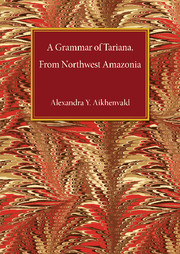Book contents
- Frontmatter
- Dedication
- Contents
- List of tables, schemes and diagrams
- Preface
- Acknowledgements
- Organisation and cross-referencing
- List of abbreviations
- Map
- 1 The language and its speakers
- 2 Phonology
- 3 Word classes
- 4 Nominal morphology and noun structure
- 5 Noun classes and classifiers
- 6 Possession
- 7 Case marking and grammatical relations
- 8 Number
- 9 Further nominal categories
- 10 Derivation and compounding
- 11 Closed word classes
- 12 Verb classes and predicate structure
- 13 Valency changing and argument rearranging mechanisms
- 14 Tense and evidentiality
- 15 Aspect, Aktionsart and degree
- 16 Mood and modality
- 17 Negation
- 18 Serial verb constructions and verb compounding
- 19 Complex predicates
- 20 Participles and nominalisations
- 21 Clause types and other syntactic issues
- 22 Subordinate clauses and clause linking
- 23 Relative clauses
- 24 Complement clauses
- 25 Discourse organisation
- 26 Issues in etymology and semantics
- Appendix. The main features of the Tariana dialects
- Texts
- Vocabulary
- References
- Index of authors, languages and subjects
10 - Derivation and compounding
Published online by Cambridge University Press: 05 August 2013
- Frontmatter
- Dedication
- Contents
- List of tables, schemes and diagrams
- Preface
- Acknowledgements
- Organisation and cross-referencing
- List of abbreviations
- Map
- 1 The language and its speakers
- 2 Phonology
- 3 Word classes
- 4 Nominal morphology and noun structure
- 5 Noun classes and classifiers
- 6 Possession
- 7 Case marking and grammatical relations
- 8 Number
- 9 Further nominal categories
- 10 Derivation and compounding
- 11 Closed word classes
- 12 Verb classes and predicate structure
- 13 Valency changing and argument rearranging mechanisms
- 14 Tense and evidentiality
- 15 Aspect, Aktionsart and degree
- 16 Mood and modality
- 17 Negation
- 18 Serial verb constructions and verb compounding
- 19 Complex predicates
- 20 Participles and nominalisations
- 21 Clause types and other syntactic issues
- 22 Subordinate clauses and clause linking
- 23 Relative clauses
- 24 Complement clauses
- 25 Discourse organisation
- 26 Issues in etymology and semantics
- Appendix. The main features of the Tariana dialects
- Texts
- Vocabulary
- References
- Index of authors, languages and subjects
Summary
Nominal derivational devices in Tariana fall into the following groups:
(a) productive derivational suffixes – see §10.1;
(b) semi-productive and non-productive derivational suffixes – see §10.2;
(c) deverbal nominalising suffixes – see §10.3;
(d) noun classifiers as derivational devices – see §5.1.3 and §10.4.
Compounding is considered in §10.5. Derivational functions of ka- ‘relative, attributive’ and ma- ‘negative’ are discussed in §17.4.
Productive derivational suffixes
Two productive derivational suffixes, -peɾi ‘old:MASCULlNE’ and -peɾu Old:FEMININE’, occur only on nouns with human referents which often also contain a gender sensitive suffix (see §10.2) or a classifier, thus creating a curious situation whereby gender is marked on the head noun more than once, e.g. di-whe-ɾi-peɾi (3sgnf-grandparent-MASC-OLD:MASC) ‘his old grandfather’; na:ka-peɾu (mother-OLD:FEM) ‘old mother’, mawaɾi-sa-do-peɾu (snake+INDF-spouse-FEM-OLD:FEM) ‘the old wife of a snake’, pedalia-ma-peɾu (old-CL:FEM-OLD:FEM) ‘an old adult woman’. Unlike any other suffixes, these suffixes can occur on vocative forms of kinship nouns, e.g. nuitõ-peɾu (daughter, VOC-OLD:FEM) ‘my old daughter!’ In 10.1, -peɾu is used on a nominalised modifier after the animate classifier -ite:
Unlike the suffixes discussed under §10.2, but like classifiers, -peɾi and -peɾu can occur on the specifier article, as in 10.2.
Another productive derivational suffix is -mi ‘remains; something useless or gone’, e.g. heku-kuda-mi (tree-CL:TRUNK-USELESS) ‘a cut-off tree trunk’, diɾa-nite-mi (3sgnf+drink-TOP.ADV+NCL:ANIM-USELESS) ‘the remains of his drink’, di-ñha-nite-mi (3sgnf+eat-TOP.ADV+NCL:ANIM-USELESS) ‘the one who has been eaten and is now gone’.
- Type
- Chapter
- Information
- A Grammar of Tariana, from Northwest Amazonia , pp. 196 - 202Publisher: Cambridge University PressPrint publication year: 2003



